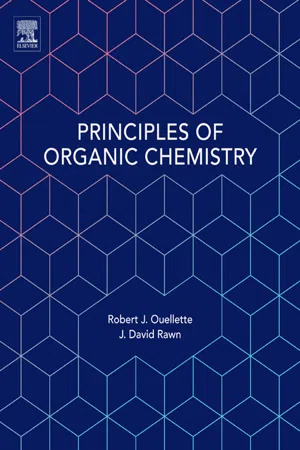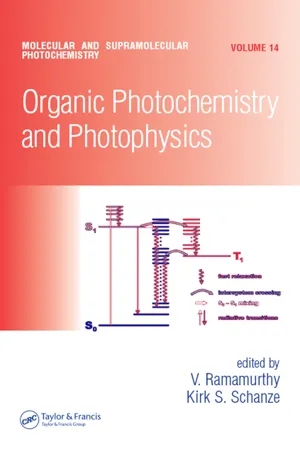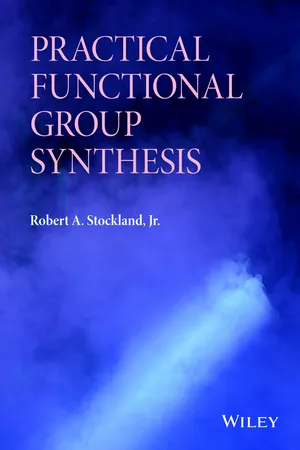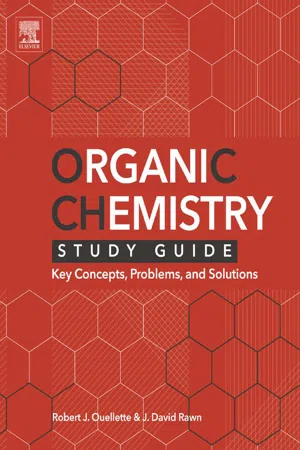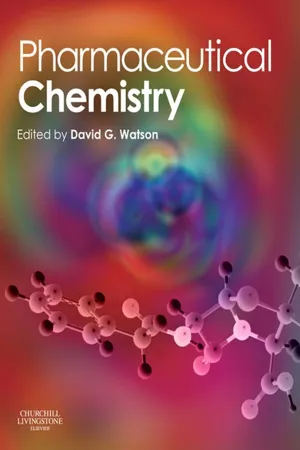Chemistry
Preparation of Amines
The preparation of amines involves the conversion of functional groups such as amides, nitro compounds, or halides to amines. Common methods include reduction of nitro compounds using metal catalysts, reduction of amides using reducing agents like lithium aluminum hydride, and nucleophilic substitution of halides with ammonia or amines. These methods are important in organic synthesis for creating a wide range of amine compounds.
Written by Perlego with AI-assistance
Related key terms
5 Key excerpts on "Preparation of Amines"
- eBook - ePub
- Robert J. Ouellette, J. David Rawn(Authors)
- 2015(Publication Date)
- Elsevier(Publisher)
The imine that forms initially is reduced to an amine. The overall process is called reductive amination. Reduction of Amides Reduction of amides is one of the most frequently used methods of preparing amines. The method is very versatile because primary, secondary, and tertiary amines are easily prepared from the corresponding class of amide. Amides are prepared by acylation of amines using activated acyl derivatives such as acid chlorides or acid anhydrides (Section 12.6). Subsequent reduction of the amide with LiAlH 4 followed by acidic workup produces the amine. Reduction of Nitriles Nitriles can be prepared from primary alkyl halides by a direct S N 2 displacement reaction using sodium cyanide as the nucleophile (Section 7.6). Then the nitrile is reduced to a primary amine with lithium aluminum hydride. Reduction of Nitro Compounds There is no synthetic procedure to introduce an amino group onto an aromatic ring in one step. However, it is possible to substitute an amino group onto an aromatic ring in two steps (Section 5.10). First the ring is nitrated. Then, the nitro group is reduced to an amino group. 12.10 Hydrolysis of Amides Hydrolysis of an amide breaks the carbon-nitrogen bond and produces an acid and either ammonia or an amine. This reaction resembles the hydrolysis of esters, which we discussed in Chapter 11. There are, however, important differences. The hydrolysis of esters occurs relatively easily, whereas amides are very resistant to hydrolysis. Amides are hydrolyzed only by heating for hours with a strong acid or strong base. When amide hydrolysis is carried out in basic solution, the salt of the carboxylic acid forms; one mole of base is required per mole of amide - eBook - ePub
- V. Ramamurthy, Kirk S. Schanze(Authors)
- 2005(Publication Date)
- CRC Press(Publisher)
1 ]. Ammonia has been industrially produced from hydrogen and nitrogen since 1908 with the invention of the Haber–Bosch process operating at temperatures of 400 to 500°C and pressures of 1000 atm in the presence of an iron catalyst. Therefore, ammonia is an easily available industrially important raw material to synthesize nitrogen-containing molecules.Amino compounds are potentially important substrates because of their significant chemical and biological activities. Usually the preparations of amino compounds are carried out by means of indirect methods such as reductions of nitro, azo, and azide or substitution of halogen, hydroxy, and alkoxy groups [2 ]. Direct amination of a carbon–carbon double bond, however, is limited to the Friedel–Crafts reaction with activated amination reagents or nucleophilic addition of amide anion to highly activated substrates, showing no common amination method in thermal reactions. Therefore, more convenient direct aminations using ammonia have been required.Ammonia and amines are photochemically reactive species acting as a base, a reductant, and a nucleophile. Therefore, the photochemical reactions may make direct amination with ammonia and amines possible to provide more convenient and powerful synthetic method among many synthetic methodologies.We review here photoamination based on a survey of the literature up to 2003.6.1.1 AMINES AS ELECTRON DONORS
It is well known that amines are typically good electron donors in the photochemical reaction, since their oxidation potentials are relatively low and their chemical reactivity is potentially high. During the 1970s, the donor–acceptor photoreactions using amines as electron donor have been extensively investigated. In 1973, Bryce-Smith et al. developed the meta-photocyclization of 1-dimethylamino-3-phenylpropane, which gave the azacyclic compounds via a C-C bond formation (Scheme 6.1) [3 - eBook - ePub
- Robert A. Stockland(Author)
- 2016(Publication Date)
- Wiley(Publisher)
3 SYNTHESIS OF AMINES, AMIDES, AND RELATED COMPOUNDSALKYLAMINES
3.1 SYNTHESIS OF ALKYLAMINES AND RELATED COMPOUNDS THROUGH NITROGEN–CARBON(SP
3) BOND-FORMING REACTIONSThe preparative routes leading to the formation of alkylamines and related compounds are quite diverse. The following section will highlight a number of these approaches with special attention paid to methods that are operationally simple, high yielding, or exhibit broad functional group tolerance.Substitution chemistry remains one of the most popular and simplest approaches to the formation of nitrogen–carbon(sp3 ) bonds. An example of this method involved the addition of pyrimidines to brominated esters (Scheme 3.1 ) [1]. The first step in this sequence was the protection of the primary amine in order to direct the reaction to the N(1)-H of the pyrimidine. Once the protection was complete, addition of a strong base deprotonated the N(1)-H and generated the amide that attacked the brominated ester to generate the new nitrogen–carbon(sp3 ) bond.Classic synthesis of nitrogen–carbon(sp3 ) bonds through substitution chemistry [1].SCHEME 3.1Another example of this chemistry generated seven-membered heterocycles through a double substitution reaction (Scheme 3.2 - eBook - ePub
Organic Chemistry Study Guide
Key Concepts, Problems, and Solutions
- Robert J. Ouellette, J. David Rawn(Authors)
- 2014(Publication Date)
- Elsevier(Publisher)
Nitriles are reduced to primary amines using lithium aluminum hydride. The nitrile can be made by displacement of a halide ion from a haloalkane by cyanide ion. This method allows the formation of primary amines having one additional carbon atom.Reduction of amides using lithium aluminum hydride is the most versatile way of producing amines. Amides are easily prepared by reaction of an acyl chloride and an amine. However, the reaction is most versatile because primary, secondary, and tertiary amines can be synthesized using primary, secondary, and tertiary amides, respectively. Reduction of nitroaromatic compounds is used to produce anilines. Tin and HCl is the usual reducing agent.23.9 Hofmann Rearrangement
The Hofmann rearrangement occurs when a primary amide reacts with a basic solution of a halogen such as chlorine or bromine. In this process, the carboxyl carbon atom is lost as carbonate ion and a primary amine results. The rearrangement occurs when an alkyl group is transferred from the carboxyl carbon atom to the nitrogen atom in one of the several intermediates involved in the reaction mechanism. The rearrangement occurs with retention of configuration of the alkyl group.23.10 Conjugate Addition Reactions
The reactions of amines are distinctly different than the reactions of alcohols. Amines are substantially stronger bases than alcohols. Amines are sufficiently basic to exist to some degree as the conjugate acid in water. Alcohols require strong acids to form the conjugate acid. Amines are much less acidic than alcohols—the pK a values of amines and alcohols are 35 and 16, respectively.Within a period of the periodic table, the nucleophilicity decreases from left to right for the elements in compounds of similar structure. Ammonia is a distinctly better nucleophile than water because nitrogen is less electronegative (EN 3.0) than oxygen (EN 3.5). Likewise, amines are better nucleophiles than alcohols. Usually, it is necessary to convert an alcohol to its alkoxide ion to make it sufficiently nucleophilic to displace a leaving group such as a halide ion from a haloalkane. The neutral amine is sufficiently nucleophilic for this type of displacement reaction. - eBook - ePub
- David G. Watson(Author)
- 2011(Publication Date)
- Churchill Livingstone(Publisher)
Chapter 3 Amines David G. Watson Chapter contents Introduction 35 Factors affecting the p Ka value of a base 36 Alkyl groups 36 Electron withdrawing groups 39 Salt formation 48 Reactions of amines in relation to storage and formulation 48 Oxidation 48 Acylation 48 Schiff’s base formation 49 Quaternary amines 52 Introduction The amine group can be considered as the single most important group for conferring pharmacological activity. This is because it is the principle group within organic molecules that bears a positive charge. When it is present in a drug molecule it can exert biological effects through electrostatic interactions with negatively charged groups within proteins and also compete with positively charged cations such as sodium, potassium and calcium ions in biological processes. Amines are derived from ammonia and have the structures shown in Figure 3.1 for mono-, di- and trisubstituted nitrogen. Figure 3.1 Amines. The structures may look planar but, in fact, the structures of amines are more or less tetrahedral, like tetrasubstituted carbon, as shown for trimethylamine in Figure 3.2. In the case of nitrogen, the position that would be occupied by a fourth bond in tetrasubstituted carbon is occupied by a lone pair of electrons. Since nitrogen is less electronegative than oxygen the lone pair within an amine structure is more available than the lone pairs on an oxygen atom to interact with a proton. An approximate measure of the availability of lone pairs of electrons is given by the energy of the highest occupied molecular orbital (HOMO). The deeper the ‘energy well’ that the molecular orbital occupies the less available the electrons are for bond formation with a proton. Thus water has a HOMO of −12.5 eV while ammonia has a HOMO of −10.5 eV, and thus its electrons are more available and it protonates more readily than water
Index pages curate the most relevant extracts from our library of academic textbooks. They’ve been created using an in-house natural language model (NLM), each adding context and meaning to key research topics.
